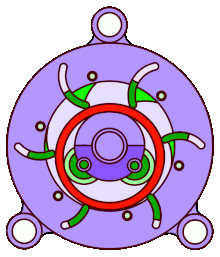Angelo Di Pietro's Rotary Positive Displacement Air Engine
hideThis article has multiple issues. Please help or discuss these issues on the talk page. (Learn how and when to remove these template messages)
|


Angelo Di Pietro's Rotary Positive Displacement Air Engine (short Di Pietro Motor), developed by Angelo Di Pietro and his Australian company EngineAir, is a rotary engine powered by compressed air. It is smaller than any internal combustion engine although the size may differ between models.
The CA-patent for this engine was published in 2001.[1] The US-patent for this engine was granted in 2005.[2]
Principle[]
Unlike other rotary engines, the Di Pietro motor uses a simple cylindrical rotary piston (shaft driver) which rolls, with next to no friction, inside the cylindrical stator.[3] Only 1 psi (≈ 6,8 kPa) of pressure is needed to overcome the friction.[4]
The space between stator and rotor is (for e.g.) divided in 6 expansion chambers by pivoting dividers. These dividers follow the motion of the shaft driver as it rolls around the stator wall. The cylindrical shaft driver, forced by the air pressure on its outer wall, moves eccentrically, thereby driving the motor shaft by means of two rolling elements mounted on bearings on the shaft. The rolling motion of the shaft driver inside the stator is cushioned by a thin air film. Timing and duration of the air inlet and exhaust is governed by a slotted timer which is mounted on the output shaft and rotates with the same speed as the motor.
Variation of performance parameters of the motor is achieved by varying the time during which the air is allowed to enter the chamber: A longer air inlet period allows more air to flow into the chamber and therefore results in more torque. A shorter inlet period will limit the air supply and allows the air in the chamber to perform expansion work at a much higher efficiency. In this way compressed air (energy) consumption can be exchanged for higher torque and power output depending on the requirements of the application (this is identical to function of the "cutoff" control in a steam engine).
Motor speed and torque are controlled by throttling the amount or pressure of air into the motor. The Di Pietro motor gives instant torque at zero RPM and can be precisely controlled to give soft start and acceleration control.
Usages[]
The Di Pietro Motor can be used in boats, cars, burden carriers and other vehicles.[5][6]
EngineAir has designed, build and tested individual four wheeled vehicles.[7][8]
A motorcycle using a pietro engine was designed and mocked-up by Australian students.[9]
Various other vehicles where conceptualized or designed.[10]
Currently, there are no mass-production build vehicles using this engine.
Environmental Implications[]
Operation of compressed air vehicles will usually be pollution free during operation. However the energy required for compression must be sourced, and will usually be derived from electricity, or an internal combustion engine. Depending on the method used to generate the electricity, the energy may still contribute some quantities of greenhouse gases and other pollutants, especially if fossil fuels are used. However, the use of multiple alternative energy sources, such as solar panels or wind turbine to power generators/compressors, could decrease the need for electricity created by fossil fuels.
Advantages over other (air) engines[]
The engine does not vibrate.[11][12] The engines produces torque when in standstill,[13] eliminating the need for parts like a starter and clutch. The engine typically does not need multiple gears.
The engine is virtually silent.[8]
Claims are being made that is more efficient then other air engines.[14][8]
Disadvantages of compressed air[]
The viability of using compressed air as energy storage has been questioned in cars by some experts given:
- the energy losses during the air compression and dehydration process
- the need for energy to add heat during the expansion phase
- the low energy density of compressed air compared to rechargeable batteries
Advantages of compressed air[]
However, although there are losses during the compression phase, heat can be stored at almost 100% efficiency,[citation needed] and an increase in air temperature is an increase in internal energy, doubling the energy density every 273 °C,[citation needed] this is comparable to rechargeable batteries,[citation needed] less weight and Non-Toxic.
In relation to energy storage efficiency, even by assuming an efficiency of only 40% for the compressed air at 200 bar and 100% for heating, the two air and heat combined[15] translate to an efficiency of 70%,[citation needed] without considering a further increase in temperature.[citation needed]
Furthermore, manufacturing cars of this type have fewer problems with safe disposal at the end of their life.[citation needed]
See also[]
- Compressed-air engine
References[]
- ^ "Rotary piston engine". patents.google.com. Retrieved July 11, 2021.
- ^ "Rotary piston engine". patents.google.com. Retrieved July 11, 2021.
- ^ "United States Patent No. US6868822B1" (PDF). www.rexresearch.com. March 22, 2005. Retrieved July 11, 2021.
- ^ "Applications". www.engineair.com.au. Archived from the original on 2018-12-22. Retrieved 2007-10-28.
- ^ "Applications". www.engineair.com.au. Archived from the original on 2016-10-02. Retrieved 2008-04-09.
- ^ "Environmentally Friendly, Engine, Invention | Melbourne". www.engineair.com.au. Retrieved 2021-07-11.
- ^ https://newatlas.com/significant-new-rotary-engine-design-runs-on-compressed-air/3185/
- ^ Jump up to: a b c https://www.ge.com/news/reports/20-09-2013pumping-up-the-silent-engine
- ^ "Australian Students' Air-Powered Bike". www.asme.org. Retrieved 2021-07-11.
- ^ https://sites.google.com/site/rijdenopperslucht/home/menu-en/engineair-en
- ^ Andrew Williams (2013-06-28). "Ecomagination ANZ Challenge Winners Set to Develop Renewable Energy Technologies". Renewable Energy World. Retrieved 2021-07-11.
- ^ https://www.epj-conferences.org/articles/epjconf/pdf/2017/12/epjconf_efm2017_02149.pdf
- ^ https://papers.itc.pw.edu.pl/index.php/JPT/article/view/196/410
- ^ https://newatlas.com/significant-new-rotary-engine-design-runs-on-compressed-air/3185/
- ^ "Esoi importance of reducing the energetic and material demands of electrical energy storage - Google Search". www.google.com. Retrieved 2021-07-11.
External links[]
| Wikimedia Commons has media related to Di Pietro Motor. |
- Compressed air power
